October 9, 2020
Air Date: October 9, 2020
FULL SHOW
SEGMENTS

Judge Barrett and Environmental Law
View the page for this story
Supreme Court nominee and Federal Appeals Court Judge Amy Coney Barrett is a conservative who tends to interpret the law narrowly, meaning that if she is confirmed, she would generally rule against innovative environmental advocacy legislation. Patrick Parenteau, a professor of environmental law at Vermont Law School, joins Host Steve Curwood to talk about Judge Barrett's record and how she might approach environmental litigation on the high court. (12:12)
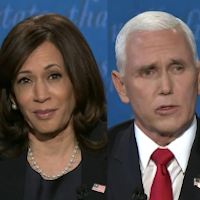
Vice Presidential Debate on Climate
View the page for this story
At the one and only Vice Presidential debate of the 2020 election, Republican Vice President Mike Pence and Senator Kamala Harris (D-CA) clashed over fracking, the Green New Deal, and whether climate change poses an existential threat to humanity. Hosts Steve Curwood and Bobby Bascomb put the statements of the vice presidential candidates on climate into context. (03:55)
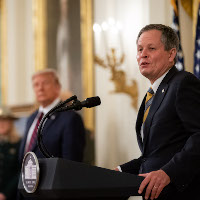
The Environment in Western Senate Races
View the page for this story
Three of this year's closest Senate races are in the western states of Colorado, Montana, and Arizona, places with a lot of public lands and where environmental issues are top of mind for voters. Yet all three Senate seats on the ballot in these states are currently held by Republican incumbents, with varying commitments to climate and environmental protection. Judy Fahys, a reporter for InsideClimate News, speaks with Host Bobby Bascomb about where the candidates stand on climate and the environment. (09:38)

Climate Change Disrupts Major Transportation Corridor
/ Dan BoyceView the page for this story
I-70 is a transportation lifeline linking East to West and an engineering marvel as it barrels through the Rocky Mountains. Earlier this summer I-70 was closed for two weeks following the Grizzly Creek Fire in Glenwood Canyon. As Colorado Public Radio’s Dan Boyce reports, it’s just one example of the transportation challenges linked to climate disruption. (05:06)

Beyond the Headlines
/ Peter DykstraView the page for this story
On this week's Beyond the Headlines, Environmental Health News Editor Peter Dykstra tells Host Bobby Bascomb about a plan to drill along the Atlantic that has fallen apart due to un-renewed seismic blasting permits. Then, the pair talk about how more K-12 schools are powering classrooms with solar energy. Finally, from the history books, the anniversary of a coal slurry spill that weakened the coal lobby's stranglehold on Appalachia. (04:48)

Enduring Against Seemingly Impossible Odds
View the page for this story
In 1914, British explorer Ernest Shackleton and his crew of 27 men set sail for Antarctica. Disaster struck when their ship the “Endurance” became trapped in pack ice and later broke up, yet optimism and sheer perseverance carried all 28 men through what seemed impossible odds. Rosamund Zander, the author of Pathways to Possibility: Transforming Our Relationship to Ourselves, Each Other, and the World, joins Host Steve Curwood to talk about how Shackleton used emotional intelligence to keep his crew going through and how we can all harness an optimistic mindset to carry us through difficult times. (10:58)
Show Credits and Funders
Show Transcript
HOSTS: Bobby Bascomb, Steve Curwood
GUESTS: Judy Fahys, Pat Parenteau, Rosamund Stone Zander
REPORTERS: Dan Boyce, Peter Dykstra
[THEME]
CURWOOD: From PRX – this is Living On Earth.
[THEME]
CURWOOD: I’m Steve Curwood.
BASCOMB: And I’m Bobby Bascomb.
PARENTEAU: How Supreme Court nominee Amy Coney Barrett might rule on environmental cases.
PARENTEAU: You have to understand an awful lot about the science of environmental law in order to fairly interpret it. I’m not sure she’s open to that kind of exploration.
CURWOOD: Also, why focusing on survival kept polar explorer Ernest Shackleton and his crew alive when their ship was crushed by pack ice.
ZANDER: Every man on this journey knew what to do. They had to speak the story of survival. They became very collaborative and when one man spilled his cup of milk four others rushed to fill it up again even when they were all starving.
CURWOOD: That and more this week on Living on Earth – Stick Around!
[NEWSBREAK MUSIC: Boards Of Canada “Zoetrope” from “In A Beautiful Place Out In The Country” (Warp Records 2000)]
[THEME]
Judge Barrett and Environmental Law
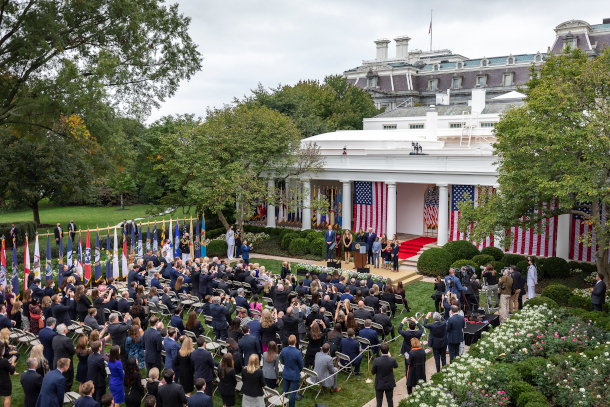
President Trump nominated Judge Amy Coney Barrett for Associate Justice of the Supreme Court on September 26, 2020. The nomination was announced in the Rose Garden of the White House. (Photo: The White House, Amy Rossetti, Flickr, Public Domain)
BASCOMB: From PRX and the Jennifer and Ted Stanley studios at the University of Massachusetts Boston, this is Living on Earth, I’m Bobby Bascomb.
CURWOOD: And I’m Steve Curwood.
Republicans are trying to rush Senate confirmation hearings for conservative appeals judge Amy Coney Barrett to replace the late Ruth Bader Ginsburg on the Supreme Court. The hearings, set to begin October 12, come amid a coronavirus outbreak that includes the President and dozens of Republican officials including 3 senators on the Judiciary Committee. Many of the people linked to the White House outbreak attended Judge Barrett’s announcement September 26th in the presidential rose garden. Judge Barrett is an acolyte of the late conservative Supreme Court Justice Antonin Scalia and at age 48 she would become the youngest justice. Strictly conservative justices more often than not rule against innovative environmental advocacy litigation. To explain how that works we turn now to Vermont Law School professor Pat Parenteau. Welcome back to Living on Earth Pat!
PARENTEAU: Thanks, Steve, pleasure to be with you.
CURWOOD: So please take a moment to walk us through a role that a Supreme Court justice plays when it comes to environmental matters.
PARENTEAU: Well, the first rule is to see whether or not Congress, when it passes environmental laws, is acting within the constraints of the Constitution. Most of our environmental laws are based on the Commerce Clause. US Congress doesn't have what states have, which is broad police power authority to protect public health and welfare, and so forth. Congress has to ground the Clean Air Act, the Clean Water Act and all of our environmental law is in some kind of impact on interstate commerce and that comes into play big time when you're talking about the Clean Water Act. And whether or not Congress can go to the limits of the Commerce Clause to protect the headwaters, let's say of our, our watersheds, the small rivers and streams and wetlands that make up the full aquatic ecosystem. A judge like Judge Barrett, who's a self-professed originalist, takes a fairly narrow view of Congress's authority under provisions like the Commerce Clause. So that will be something to really watch early on, when, as we know, some of the anti-regulatory forces will begin challenging not only the rollbacks that Trump has put in place, but even going back to some of the prior rules that were in place, under President Obama and others. Some of those rules could be at risk with a strict constructionist, when it comes to the Constitution.
CURWOOD: So what is Judge Barrett's voting history, which could indicate her stance on matters that are likely to come up and in cases involving the environment?
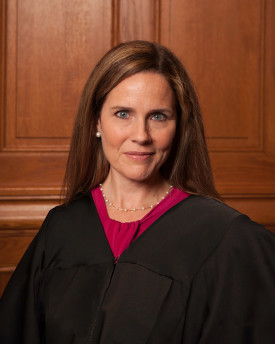
Amy Coney Barrett sits on the Court of Appeals for the Seventh Circuit in Chicago and was a professor at Notre Dame Law School. (Photo: Rachel Malehorn, Wikimedia Commons, CC BY 3.0)
PARENTEAU: Yeah, we have to look mostly at what she has said in her writings. She was a law professor for many years at Notre Dame law school on the Seventh Circuit where she's been for the last several years. She has not actually written any majority opinions dealing with environmental law but she is very outspoken on matters of constitutional interpretation, and particularly statutory interpretation. And because she is described as a protege of Justice Scalia, she said in accepting President Trump's nomination, I intend to follow the lead of Justice Scalia, in the way I approach my job if I'm confirmed. And what that means is when it comes to interpreting statutes, Justice Scalia was a textualist, as is Judge Barrett, which means that you don't so much look to the purposes of the laws that Congress enacts, for example, the Clean Air Act, the Clean Water Act, the Endangered Species Act, most of these laws have very strong environmental objectives and purposes. And sometimes the words of the statute don't fully reflect the policies and the purposes that drove the law to begin with. And that's where the words of a statute become critical. A judge, like Judge Barrett would not necessarily pay much attention to the statement of purpose or policy, she would zero in on the narrowest definition of the word in question. So that could really limit federal power to protect natural resources.
CURWOOD: So what are some of the cases that are likely to come up fairly soon with this, if we end up with a, basically a six to three conservative Supreme Court to deal with them?
PARENTEAU: Yeah, let's talk about the climate cases, because those are the ones that are, I think, going to be most at risk. The Trump administration, of course, repealed Obama's Clean Power Plan, which was one of the major features of his attempts to deal with climate change. And it's been replaced by something called the Affordable Clean Energy Act, which is a misnomer but that's what it's called. And it doesn't do anything at all, to deal with climate change and in fact, it increases the threats to public health by allowing a lot of dirty old plants to continue to operate. So that case is now being argued in the DC Circuit Court of Appeals. And from there, it's almost certain to go to the Supreme Court. And that's going to put front and center what exactly is the power of the EPA to use the Clean Air Act to deal with climate change to deal with power plants. And the rule that's right behind it is the rule dealing with automobile emissions and fuel economy standards. And once again, the Trump administration has rolled back the Obama rules which was driving us towards 50 miles per gallon, with much cleaner vehicles, electric vehicles, and hybrid vehicles. Trump has rolled all that back to about 28 miles per gallon. That's going to end up in the Supreme Court and that'll be another question both of what's the scope of EPA's is authority under the Clean Air Act, but in the case of the tailpipe standards, it also raises the question whether California which has historically been given an extra authority to deal with air pollution given their very severe air pollution problems in the Los Angeles Basin, there's also going to be a question of whether the Trump administration's revocation of California's authority to set stricter standards would also be overruled. That is to say California's is attempts to regulate would be struck down, that would eliminate one of the most potent federal tools, we have to reduce greenhouse gas emissions. And then there's the methane rule right behind that, and whether or not EPA can regulate methane coming from oil and gas wells across the country. So just looking at that one issue of the Clean Air Act, and climate change, there are three cases lined up, all of which could potentially get to the Supreme Court in front of this new 6 - 3, almost ironclad conservative majority of the court.
CURWOOD: There's been some discussion that if the Democrats in fact do take the White House and the Senate along with the House that they might want to expand the Supreme Court, say to 11 and appoint two more justices and shift the balance. Your views?
PARENTEAU: So I know that's very much in discussion and tempting, I'm sure if the Democrats do take control of the government, but the problem with that is you're going to have an endless sequence of people continuing to change the number of justices on the court, depending on who's in power. So I'm not sure that that's a really good long term solution as tempting as it may be. There's also some discussion about term limits and limiting the terms of justices on the court that might have more appeal. I mean, I think actually, that makes some sense. It won't help with the current members of the court, though, they're not going to retro actively impose term limits on people that were appointed for life. But in terms of future appointments, maybe term limits would make some sense.
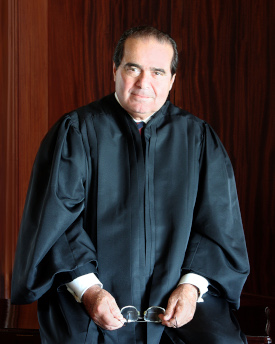
The late Supreme Court Justice Antonin Scalia played a crucial role in the landmark climate change case Massachusetts v. EPA. (Photo: Collection of the Supreme Court of the United States, Flickr, Public Domain)
CURWOOD: There's been some cynical remarks saying, well, Trump is designating Judge Barrett because she's a woman and she's young. So she'll be around without necessarily revealing her qualifications. From what you know, how sharp a jurist is, she Scalia was very conservative, but also very smart.
PARENTEAU: Yeah, I think I'd have to say she's also very smart. And she's also very candid, frankly, I've read two of her articles, just to get a sense of does she confront the other side of the positions that she's taking? And she does. She frankly acknowledges when it comes to questions of statutory interpretation, that it's a very difficult job for the court to perform. because you're on the one hand, courts are supposed to be deferential to the legislative branch. But on the other hand, they're supposed to exercise independent judgment about what the words of a statute mean. And you could certainly find interpretations of statutes that go against what the real intent of a Congress was. I mean, when you look at environmental law, it's always responsive. I mean, we didn't pass the Clean Water Act, until we had rivers catching fire. We didn't pass the Clean Air Act, until people were literally choking in the smog of Los Angeles. The point being, Congress is often reactive to these problems. And when they pass laws, they can't envision all that has to be done in order to deal with them. That's why they leave to agencies discretion to let laws sort of evolve and adapt as time goes by. But a doctrine that says we're going to stick to the original intent and words of the statute, we're not going to try to take into account these broader goals and purposes, that cuts directly against what Congress is trying to do with environmental law, which is oftentimes remedial in nature and long term in nature. Barrett has acknowledged that tension she has said, you know, judges face a difficult job of balancing their duty to the Constitution, to say what the law is, but also to be respectful of the fact that legislators sometimes have to enact laws that are very general in their scope, and that don't have all the specificity that you might want. So I think she's an honest, although conservative judge, I would not discount the fact that she could evolve and grow as a justice, but clearly she's going to start from a place. That means environmental law in particular is going to have a very hard time you have to understand an awful lot about the science and the technologies or the technical aspects of environmental law, you really have to spend time trying to understand what environmental law is trying to accomplish in order to fairly interpret it. I'm not sure she's open to that kind of exploration of what is the law of trying to do. If she's going to take this approach, if all I want to do is determine what this word means she's going to miss an awful lot of the nuance that goes with environmental law.
CURWOOD: These days, you see a bill come in front of the Congress, and it's as thick as a book, or maybe even a stack of books that seems that nobody actually reads through. To what extent does Congress now have to start paying a lot more attention to really understanding what it's passing?
PARENTEAU: Oh, I think that is absolutely right. You know, when Congress passed the Clean Water Act, they invented a term waters of the United States. They didn't define it they didn't know what it meant. That's clear from the legislative history. It was kind of thrown in at the last minute in the conference report. That can't happen anymore. The Supreme Court's not going to pass that. Congress is going to have to do the hard work of figuring out what it wants the agencies to do, and spelling it out in plain English, understandable English. and, you know, that's just the way it's going to be and if Congress doesn't do that, you're going to find the Supreme Court making decisions based on what they think the words mean, not necessarily what Congress was trying to accomplish.
CURWOOD: Pat Pareteau is a professor of law at Vermont Law School. Pat, thanks so much for taking the time with us today.
PARENTEAU: Good to be with you, Steve. Thanks.
Related links:
- Politico | “What Amy Coney Barrett Could Mean for Climate Law”
- E&E News | “Could Barrett 'Shut the Courthouse Doors' on Enviros?”
- Learn more about Justice Scalia’s role in Massachusetts v. EPA
[MUSIC: The O’Neill Brothers, “Red River Valley” on Sing Me To Sleep: Piano Lullabies, by Fred Mendelsohn and Ira Mack, Shamrock-n-Roll Records]
BASCOMB: Coming up – How disasters linked to climate disruption can be tough on transportation. That’s just ahead on Living on Earth.
ANNOUNCER: Support for Living on Earth comes from Sailors for the Sea and Oceana. Helping boaters race clean, sail green and protect the seas they love. More information at sailors for the sea dot org.
[CUTAWAY MUSIC: Ray Charles, “The Genius After Hours” on The Genius After Hours, by Ray Charles, Atlantic Masters]
Vice Presidential Debate on Climate

Senator Kamala Harris (D-CA) and Vice President Mike Pence spent several minutes discussing climate change at the one and only Vice Presidential debate of the 2020 election. (Photo: CBS News Screenshot)
BASCOMB: It’s Living on Earth I’m Bobby Bascomb.
CURWOOD: And I’m Steve Curwood.
CURWOOD: So, Bobby, I know we both watched the vice presidential debate and once again the moderator actually asked the candidates a question about climate change!
BASCOMB: Yes, Susan Page from USA Today began by asking Vice President Pence if he believes the scientific consensus that climate change is responsible for making fires and hurricanes more destructive.
PENCE: Now with regard to climate change, the climate is changing, but the issue is what’s the cause and what do we do about it? President Trump has made it clear that we’re going to continue to listen to the science. Now Joe Biden and Kamala Harris would put us back in the Paris Climate Accord. They’d impose the Green New Deal, which would crush American energy, would increase the energy costs of American families in their homes, and literally would crush American jobs.

Hurricane Delta crosses the Yucatan Peninsula on October 7, 2020. During the debate’s climate change discussion, Vice President Pence stated that hurricanes aren’t becoming more frequent. This is correct but misleading: scientists say rising temperatures are making hurricanes more destructive because of higher wind speeds as well as more capacity to dump large amounts of rainfall. (Image: Lauren Dauphin, NASA Earth Observatory image, using MODIS data from NASA EOSDIS/LANCE and GIBS/Worldview)
CURWOOD Senator Harris could not agree, and pointed to the Trump EPA website.
HARRIS: Do you know, this administration took the word science off the website, and then took the phrase climate change off the website? We have seen a pattern with this administration, which is they don’t believe in science. And Joe’s plan is about saying we’re going to deal with it, but we’re also going to create jobs. Donald Trump, when asked about the wildfires in California, and the question was, the science is telling us this… You know what Donald Trump said? Science doesn’t know.
BASCOMB: Vice President Pence defended the administration on the environment.
PENCE: I'm very proud of our record on the environment and on conservation. According to all of the best estimates, our, our air and land are cleaner than any time ever recorded. And our water is among the cleanest in the world.
CURWOOD: To say that this administration is committed to the environment just doesn’t ring true based on their actions of the last 3 and a half years.
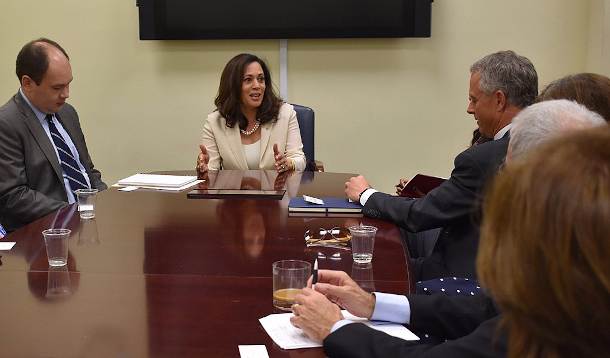
Senator Kamala Harris at a meeting with the League of Conservation Voters, the organization that rates members of Congress on how pro-environment they vote. Senator Harris has an LCV Lifetime Score of 91%, compared to Vice President Pence at just 4%. (Photo: United States Senate – Office of Senator Kamala Harris, Public Domain)
BASCOMB: Absolutely, the Trump Administration has rolled back or is in the process of rolling back roughly 100 environmental regulations in its tenure, many of which protect the very air and water they claim to be so concerned about.
CURWOOD: Exactly, and after equivocating about what’s causing climate change Vice President Pence did then turn to what he sees as this administration’s success when it comes to reducing dangerous carbon emissions.
PENCE: You know what's remarkable is the United States has reduced CO2 more than the countries that are still in the Paris Climate Accord, but we've done it through innovation and we’ve done it through natural gas and fracking.
BASCOMB: Yeah, that’s also not true. I mean US emissions are down about 10 percent over the last 10 years but more than a dozen other countries still in the Paris agreement have reduced their emissions on the order of 20 percent. And we should note, most of the emissions reductions we have achieved in the US are a result of the economic downturn and the collapse of coal, despite the President Trump’s pledge to save the coal industry.
CURWOOD: Right, and as I understand it carbon emissions are set to rise again in the U.S. mostly due to those environmental roll backs you mentioned earlier.
BASCOMB: Exactly.
CURWOOD: Well, later in that same question Vice President Pence said that fracking for natural gas is partly how the US has reduced emissions and suggested that Joe Biden and Kamala Harris would ban fracking. Here’s Senator Harris.
HARRIS: The American people know, that Joe Biden will not ban fracking. That is a fact. That is a fact.
BASCOMB: Now Steve, you talked to Former Secretary of State John Kerry recently about Joe Biden’s environmental plan and his stance on fracking. What is their position exactly?
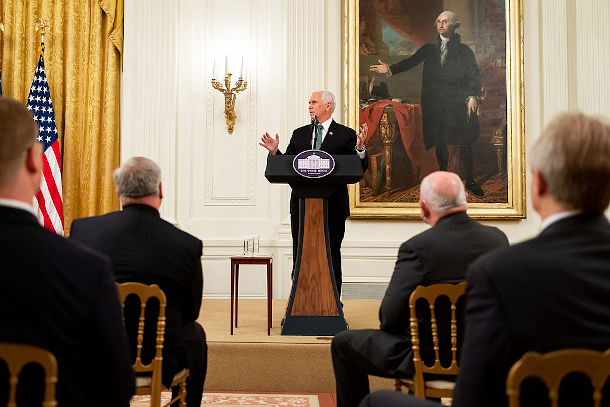
Vice President Pence delivers remarks prior to President Donald Trump’s signing of The Great American Outdoors Act on August 4, 2020, a bipartisan law that Pence touted during the debate as evidence of action the Trump administration has taken to protect the environment. (Photo: D. Myles Cullen, Official White House Photo)
CURWOOD: I did. Yes, the Biden plan that John Kerry co-chaired would ban new fracking leases on public lands but wouldn’t address private lands at all or existing leases on public lands. So, to say a Biden Harris administration would ban fracking all together is just not true.
BASCOMB: Well, I think everyone can agree that the Vice Presidential debate was much more civilized than the presidential debate but still it seems truth was a bit of a casualty here.
CURWOOD: Yes, indeed.
Related links:
- WATCH -- CBS News: Pence and Harris spar over climate change, fracking and the U.S. economy
- Learn about the link between hurricanes and climate change
- John Kerry discussed the Biden-Harris climate plan with Living on Earth
- ICYMI: Living on Earth’s coverage of Kamala Harris and Environmental Justice
[MUSIC: Roy Hargrove, Christian McBride, Stephen Scott ”Laird Baird” on Parker’s Mood, The Verve Music Group]
The Environment in Western Senate Races

Republican Senator Steve Daines of Montana delivering remarks just prior to President Trump signing the Great American Outdoors Act. (Photo: Tia Dufour, The White House, Public Domain)
BASCOMB: The White House corona virus outbreak has shifted the conversation in favor of Joe Biden, and the prospects for Democrats to take a number of Senate seats. We turn now to the Rocky Mountain west – Montana, Colorado, and Arizona where there are vast amounts of public land and an electorate who value the outdoors for activities like fishing, hunting, hiking, camping and skiing. In fact, the right to a "clean and healthful environment" is even in the state constitution of Montana. Yet all three Senate seats up for election in the region are currently held by Republicans with varying commitments to environmental protection. For more I’m joined now by Inside Climate News reporter Judy Fahys. Judy, welcome to Living on Earth.
FAHYS: Hi, thanks for having me.
BASCOMB: Well, let's start with Colorado, where Republican incumbent Cory Gardner is looking to defend his seat from a Democratic former governor John Hickenlooper. Now Mr. Gardner actually sponsored the Great American outdoors Act, which was a bipartisan bill passed this year, providing funding for the Land and Water Conservation Fund, along with the country's national parks, but he has an 11% lifetime score from the League of Conservation Voters, meaning he's voted in a way that LCV views as favoring the environment just 11% of the time, that's pretty abysmal. How do you square that circle?
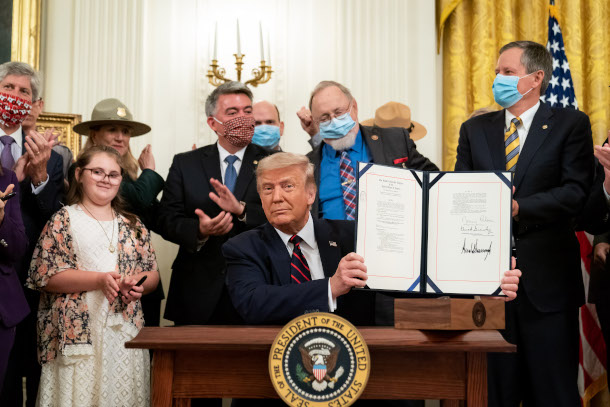
Republican Senators Steve Daines (far right of photo) of Montana and Cory Gardner of Colorado (back left of President Trump), among others, look on as President Trump displays his signature on the Great American Outdoors Act. (Photo: Tia Dufour, The White House, Public Domain)
FAHYS: So, Cory Gardner and Steve Daines went to probably the Republican leadership but definitely to the president in the last year or so. And basically said, look, we really need to appeal to our conservation minded voters in the West because even people who like to hunt and fish, consider the public land, their land as well. And they really care about protecting the environment.
BASCOMB: And you mentioned that Steve Daines was one of those supporters. He's the republican senator from Montana that we'll talk about a bit later.
FAHYS: Right, right. Daines and Gardner were the two people who went to the Republican leaders and the president and asked for support. And they gave that support, because they knew that the elections in both of those states would be pretty tight. And then in March, Senator Daines and Senator Gardner went to the president and said, look, could you give us the Great American Outdoors Act? Could you help us get that passed? And the president said, okay, I'll support that. And lo and behold, by the end of the summer, this elusive funding of like $900 million dollars a year for public lands, and parks around the country was freed up, and Daines and Gardner again, because of their touchy election situation, they got this vote to move forward and they were successful.
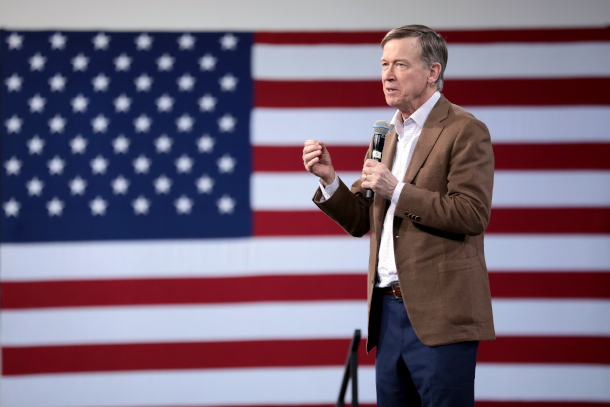
Former Democratic Governor John Hickenlooper of Colorado is running for Gardner’s Senate seat. (Photo: Gage Skidmore, Flickr, CC BY-SA 2.0)
BASCOMB: Now, Colorado is more of a purple state, they're turning blue slowly, but surely, it seems. And people that really enjoy the outdoors. I actually lived in Colorado for a time and it seems everybody's either into mountain biking, hiking, skiing, people really, really value their public lands. So this seems like a no brainer for him to support. But with an 11% lifetime score from the LCV, where else does he stand when it comes to climate change and the environment more broadly, not just with public lands?
FAHYS: Yeah. You know, Cory Gardner actually had done a little bit of work on his committees, trying to get money for the National Renewable Energy Laboratory, which is actually based in Colorado. And he, like a lot of Republicans these days are talking about technology as a solution to climate change. They don't really say, you know, this is a crisis. But they do say this is something that we can do something about, and let's look to technology to answer the question. So on the one hand, he does have a lot of support from the energy industry. But on the other hand, he has not really been what you would call a strong supporter of pro climate legislation and pro climate policies. He doesn't favor the Green New Deal, but again, I don't think John Hickenlooper does, either. Also, Senator Gardner doesn't support the Paris Climate Agreement. So that's actually one distinguishing point, I think between him and John Hickenlooper, his Democratic opponent.
BASCOMB: Well, let's talk more about john Hickenlooper. He's been the mayor of Denver, governor of Colorado, he briefly threw in his hat in the ring for the Democratic presidential nomination last year. But before politics, he was a petroleum geologist. That's a person who looks for oil and gas to extract. Can you tell us more about Mr. Hickenlooper's environmental track record?
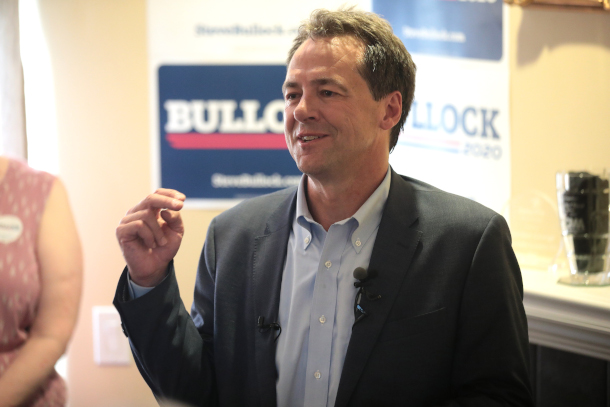
Governor Steve Bullock, a Democrat in Montana, is running for Steve Daines’ Senate seat. (Photo: Gage Skidmore, Flickr, CC BY-SA 2.0)
FAHYS: Well, that's also been really fascinating to watch the evolution back in 2017, then Governor Hickenlooper asked for a climate plan for the state and that actually has been delivered. And he's been actually a big supporter as both the mayor and the governor of increasing electric vehicles and expanding energy efficiency and expanding renewables. But he also has been considered kind of a friend, or at least moderate on issues about energy and mining. I think he's been walking kind of a fine line. And maybe it's sort of the opposite reflection of what Cory Gardner is in. They both have to seem like they're kind of moderate because it isn't a blue state or a red state. It's a purple state.
BASCOMB: Well, let's move along to the Montana race, where Republican incumbent Steve Daines is up against Democratic governor Steve Bullock.
FAHYS: That's also I enjoyed so much reporting the Montana story because Montana politics are just so lively. Currently, Steve Daines and Steve Bullock are about a point apart in the polls. The race has moved from Bullock leading to Daines leading after the passage of the Great American Outdoors Act was talked about earlier.
BASCOMB: And where did the candidate stand more broadly when it comes to the issue of climate change in Montana?
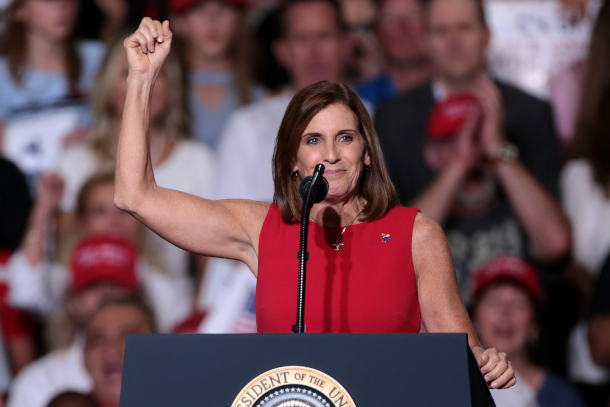
Republican Martha McSally is running for reelection in Arizona’s special election. (Photo: Gage Skidmore, Flickr, CC BY-SA 2.0)
FAHYS: Yeah, Steve Bullock actually was a presidential candidate over the last year. And you know a lot more about where he stands on climate change because climate change was a question that was put to all of the Democratic candidates in the early part of the race. He supports the Paris Climate Accord, he thinks a climate action is urgent. And in fact, there was a great headline to a New York Times column that said that Steve Bullock was actually the most important person on the planet. And that was because the more Democrats that are elected in this election to the Senate, the more likely it is that the Senate will be able to take action on climate change, which has been blocked by Senator Mitch McConnell.
BASCOMB: Well, let's turn to Arizona now, Arizona shattered all sorts of heat records this summer. To what degree is climate change on the minds of voters there?
FAHYS: You know, it's actually a fairly significant issue for Arizona, they've had a series of years where the number of heat deaths are going up and heat waves are kind of a part of life. Meanwhile, water from the Colorado River Basin is declining. And they rely on that water to sustain their communities and to sustain their growth.
BASCOMB: Now, Arizona's race is a special election to fill the seat of former senator John McCain. The seat is currently held by Martha McSally, who was appointed by the Republican governor there in Arizona, and McSally faces Democrat Mark Kelly, a former astronaut. What have each of these candidates had to say on climate change in the environment?
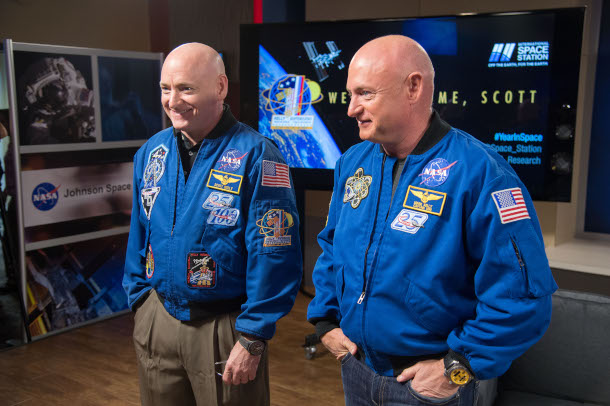
Former astronaut Mark Kelly (right) is running as a Democratic candidate for U.S. Senate in Arizona’s special election. (Photo: NASA, Flickr, CC BY-NC 2.0)
FAHYS: Well, Martha McSally is also a member of the Senate resources, Natural Resources Committee. And she really hasn't talked a lot about climate change, except to the extent that she talks about energy technology. And she recognizes that water is a an issue that needs to be addressed. But it's actually kind of interesting because Mark Kelly is married to Gabby Giffords, the Congresswoman who was shot and almost killed in 2011. And this is his first run at public office. He's been bringing the climate change question to the race in an interesting way. He talks about watching the earth change from space. And he talks about how it looked different, even over the 10 years of his different flights into space. He could see deforestation, for instance, and that that affected him. Like other Democrats, he talks about clean energy jobs and how that could help advance climate action, while also improving the economic and social status of the people in his state.
BASCOMB: Well, all of these western states that we've been talking about, Colorado, Montana and Arizona, they are all very dry. They're at high risk for wildfires and home to vast amounts of public lands that people really enjoy there. Generally speaking, how important do you think climate change and the environment are for voters there?
FAHYS: There's an organization called Colorado College, which puts out a poll every year for the last 10 years, called the State of the Rockies. And in those polls, the voters say that how candidates talk about clean air, clean water, and the environment in general factors into the votes of about 80% of the people in the West. And that's true of Arizona and Colorado, and Montana. So it's a really important factor. People care about the land that they live on and the air that they breathe. This summer in the West wildfire has polluted the air across the country. But it's particularly important in the West.
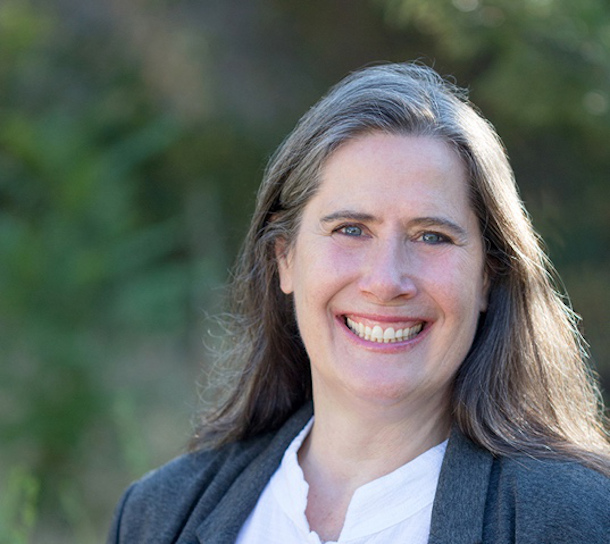
Judy Fahys is a reporter for InsideClimate News. (Photo: Courtesy of Judy Fahys)
BASCOMB: Judy Fahys is a reporter for Inside Climate News. Judy, thank you so much for taking this time with me today.
FAHYS: Thank you.
Related links:
- About Judy Fahys
- InsideClimate News | “Senate 2020: In Colorado, Where Climate Matters, Hickenlooper is Favored to Unseat Gardner”
- InsideClimate News | “Senate 2020: In Montana, Big Sky Country, Climate Change is Playing a Role in a Crucial Toss-Up Race”
- InsideClimate News | “Senate 2020: With Record Heat, Climate is a Big Deal in Arizona, but It May Not Sway Voters”
- ICYMI: LOE's coverage of the Maine Senate race
- ICYMI: LOE's discussion about four key Southern Senate races
[MUSIC: Matt Waldrum, “Rocky Mountain High” at http://mattwaldrum.com/ by John Denver]
Climate Change Disrupts Major Transportation Corridor

The Grizzly Creek Fire, which started on August 10, 2020, kept the I-70 highway closed for two weeks. (Photo: White River National Forest / U.S. Forest Service, Wikimedia Commons, Public Domain)
CURWOOD: We stay in the Rocky Mountain west now. I 70 is the only major interstate highway that runs over the continental divide in Colorado. And earlier this summer it was closed for two weeks following the Grizzly Creek Fire in Glenwood Canyon. As Colorado Public Radio’s Dan Boyce reports, it’s just one example of the transportation challenges linked to climate disruption.
BOYCE: Summer 2020 was going gangbusters for Steve Nieslanik.
NIESLANIK: Prior to the canyon flows, it was the best five weeks we ever had.
BOYCE: He owns an Indian restaurant called ‘Masala and Curry’ in the Colorado mountain town of Glenwood Springs. Tourists were pouring over the continental divide from the densely populated Denver Metro area, looking for that COVID summer staycation. And they were using this area's biggest --really it's only -- major transportation artery, interstate 70.
NIESLANIK: And then, when the interstate closed, it was like none.
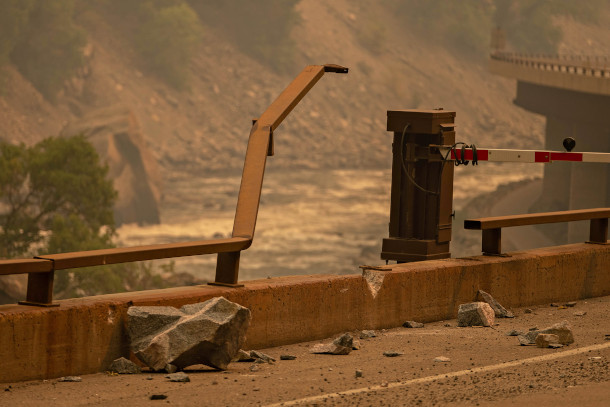
Many of California’s roads had to stay closed due not only to the fire, but to excessive traffic accidents. (Photo: White River National Forest / U.S. Forest Service, Wikimedia Commons, Public Domain)
BOYCE: It was the Grizzly Creek wildfire burning through nearby Glenwood Canyon. The canyon is so steep, so narrow, that it can't even accommodate for interstate lanes. Instead, a massive bridge deck built into the cliff side carries the westbound lanes above the eastbound lanes for miles, all while the Colorado River rushes on down below. Paul Chinowsky teaches environmental design at the University of Colorado. He says the corridor already has its share of dangers.
CHINOWSKY: These great cliffs, thiet grades -- these are perfect areas where we could have risk from roads being closed due to boulders coming down.
BOYCE: Or landslides or flash floods or avalanches -- all kinds of stuff. All right, fine, but we got to get across the mountains, right? Janoski says trouble is hen these roads were built, engineers were using their perception of the local environment at the time to judge risk factors.
CHINOWSKY: The issue with climate change is all of these factors are changing.
BOYCE: Chinowsky helped author the transportation chapter of the most recent national climate assessment. It says “increased drought and heat, coastal flooding and more heavy rain events. All of it will decrease the reliability of the nation's travel infrastructure and increase the cost to maintain it.”
The Grizzly Creek Fire closed interstate-70 for two weeks back in August. Even still, there's a section of Glenwood Canyon reduced to one lane of traffic each way. The canyon walls consist of these striking horizontal layers of crumbling rock hundreds of feet high, layers normally covered in greenery. Now, what you notice is so much of it is black and charred.
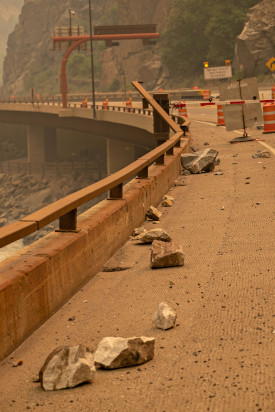
A boulder fell from the cliffs and crashed into the guardrail, bending it, before the rock shattered, leaving debris scattered. (Photo: White River National Forest / U.S. Forest Service, Wikimedia Commons, Public Domain)
LEW: You can see right behind you that the fire came right up to the road.
BOYCE: That's Colorado Department of Transportation director Shoshona Lew on a recent tour of the canyon for state officials. With the stabilizing vegetation now gone from the cliff sides, this stretch will see problems for years. More rock slides, avalanches, and closures from future rain and snow storms, storms that climate change make harder to predict. Lou says her department does have a team of geohazard experts.
LEW: They know what to look for when a rock could be vulnerable and they know how to identify when we need to take rocks down in order to avoid the falling into the road.
BOYCE: Meanwhile, the U.S Geological Survey is placing monitoring devices through the stretch to help landslide prediction models and the U.S Forest Service is looking into the potential for revegetation.
Examine just this most recent interstate 70 closure and quickly see cascading consequences. Greg Fulton runs a Colorado trade group focused on the trucking industry.
FULTON: A lot of the time we look at I-70 as almost our own little neighborhood street sometimes.
BOYCE: Of course it isn't, though.
FULTON: Businesses and consumers throughout the country get affected when there's any significant closure of this highway.
BOYCE: You see there just aren't that many reliable ways for a semi-truck to get over the Rocky Mountains. Fulton says the Colorado options besides I-70..
FULTON: They’re twisting and we don't have as much in the way of passing lanes. Nor is there any truck parking there.

The sky appears orange and smoky as the Grizzly Creek Fire continues to rage. (Photo: White River National Forest / U.S. Forest Service, Wikimedia Commons, Public Domain)
BOYCE: He says truckers outside Colorado will often opt to bypass the state entirely during an I-70 closure. More mileage, more money, more time. Colorado senator Michael Bennet on that Glenwood Canyon fire tour paints what happened here as an opportunity.
BENNET: We need to put more people to work in our forests doing the fire mitigation and the work that can be done to help prevent these fires from happening in the first place and make them easier to fight when they happen.
BOYCE: That could mean a lot of jobs in the rural West. Congress would have to pay for them though. And looking at transportation spending, the American Society of Civil Engineers estimates there's already a $1.2 trillion dollar gap in funding for travel infrastructure nationally. And that's before the impacts of climate change are taken into account.
CURWOOD: That’s Colorado Public Radio reporter Dan Boyce.
Related links:
- Learn more on the Colorado Department of Transportation Website
- Read more on CODOT’s 50th Anniversary of the Interstate System
- Stay up to date on the Grizzly Creek fire at InciWeb
[MUSIC: Eric Tingstad, “Rhythm Of the Desert” on Southwest, by Eric Tingstad, Cheshire Records]
BASCOMB: Coming up – solar power to help balance school budgets, That’s just ahead on Living on Earth.
ANNOUNCER: Funding for Living on Earth comes from you, our listeners, and United Technologies, combining passion for science with engineering to create solutions designed for sustainability in aerospace, building industries, and food refrigeration.
[CUTAWAY MUSIC: Eric Tingstad, “This Train of Thought” on Electric Spirit, by Eric Tingstad, Cheshire Records]
Beyond the Headlines
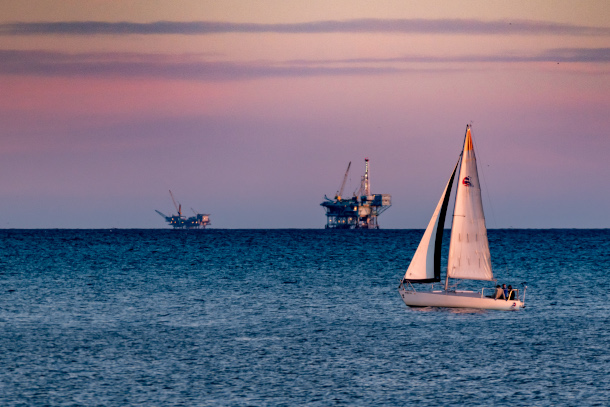
Plans for drilling off the Atlantic coast were stopped after seismic blast permits were set to expire and go un-renewed. (Photo: Glenn Beltz, Flickr, CC BY 2.0)
CURWOOD: It’s Living on Earth, I’m Steve Curwood.
BASCOMB: And I’m Bobby Bascomb.
It’s time for a trip now Beyond the Headlines with Peter Dykstra. Peter is an editor with Environmental Health News, that’s EHN dot org and Daily Climate dot org.
DYKSTRA: Hi Bobby, there's a little bit of news that's flipped on the conventional wisdom, instead of people working to save whales, in at least one court case on the Atlantic coast, whales have helped save humans.
BASCOMB: Oh, how's that?
DYKSTRA: Well, there's some situation along the eastern coast of the US where the Trump administration had wanted to pursue seismic testing as the first step in the search for offshore oil. Seismic testing is contended to have done damage to whales and other marine mammals. Seismic testing is the firing of these huge compressed air cannons fired at the ocean floor and the feedback from those explosions helps determine whether or not there's oil and gas beneath the ocean floor. And because of court cases in South Carolina and elsewhere, the Trump administration appears poised to drop its efforts for permits for seismic testing, which means no offshore oil in the Atlantic.
BASCOMB: Well, I know that the governors of these coastal states are opposed to drilling for oil off their shores and President Trump exempted Florida from offshore oil drilling but how have the oil companies themselves responded to this news?
DYKSTRA: They haven't really responded much at all, possibly because oil drilling on the East Coast is something they never wanted in the first place. It's politically controversial. It involves risk of potentially catastrophic spill in some of our most beloved beach areas. And it's just not financially worth it. Any kind of offshore oil and gas recovery is expensive and this particular proposal comes at a time when oil is cheap. In other words, spending extra to get oil that is going to have a far lower profit margin and a much higher political expense.
BASCOMB: All right, well, thank you to the whales, then. What else do you have for us this week?
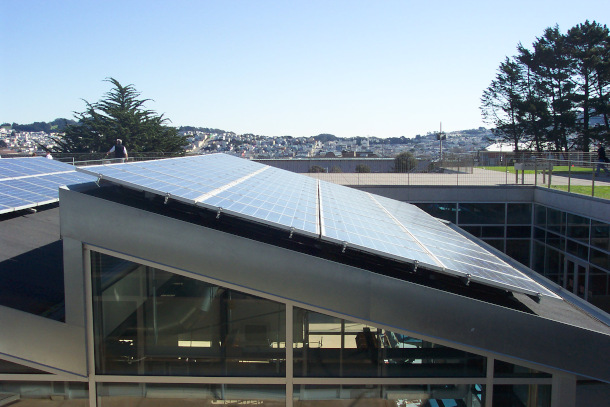
Solar panels on Lick-Wilmerding High School in San Francisco, California. (Photo: mjmonty, Flickr, CC BY 2.0)
DYKSTRA: There's a little good news, according to a solar industry report, there's an 81% increase in K through 12 schools, kindergarten through high school that use solar power. That increase over the last five years, means 5.3 million kids and teens are going to school using solar energy.
BASCOMB: Wow, that's amazing. I mean, it's very forward thinking, you know, and stands to reason for an organization that's inherently thinking about the future, you know, educating children,
DYKSTRA: And a couple of practical concerns number one are schools are chronically underfunded, this may be another way to save energy costs. Schools just like a Walmart or a Target or a Costco have a lot of roof space and that roof space can be making energy and making money instead of being a neutral item on stretch school budgets.
BASCOMB: Yeah, for sure. What do you have for us from the history books this week?
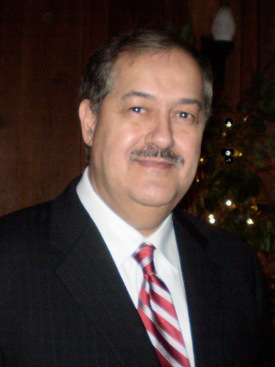
Don Blankenship, former CEO of Massey Energy, was sentenced to a year in prison after he was found guilty of conspiring to willfully violate mine safety and health standards. (Photo: Brianhayden1980, Wikimedia Commons, CC BY-SA 3.0)
DYKSTRA: October 11, 1980 fourty years ago, a coal company called Massey Energy saw its coal slurry dam fail, sending contaminated water through a couple of communities and into the Big Sandy River that's on the West Virginia Kentucky border, causing a tremendous water pollution problem. The Ohio River downstream is a major drinking water source for the region. That particular incident didn't bring with it a high death toll but almost exactly 30 years later in 2010, another Massey Energy project, a mine at Upper Big Branch in West Virginia caught fire, partly collapsed. Twenty-nine miners were killed and in an unprecedented legal move the flamboyant CEO of Massey Energy, Don Blankenship was sent to jail for a year for mine safety violations that killed those 29 miners.
BASCOMB: Well, one year in prison for the death of 29 people I mean, doesn't sound like very much.
DYKSTRA: It doesn't sound like very much but because it's set a precedent and began to shake the stranglehold that big coal had on Law and Justice in the environment in Appalachia. It was a significant move. Don Blankenship was also a major political player, going to jail for a year certainly brought him down a notch as well.
BASCOMB: All right well, thank you Peter. Peter Dykstra is an editor with Environmental Health News that's ehn.org and dailyclimate.org. We'll talk to you again real soon.
DYKSTRA: All right, Bobby, thanks a lot. Talk to you soon.
BASCOMB: And there's more on these stories at the Living on Earth website that's loe.org.
Related links:
- Washington Post | “Trump Plan to Allow Seismic Blasts in Atlantic Search for Oil Appears Dead”
- Environmental Health News | “Solar Power on the Rise at US Schools”
[MUSIC: Peter Rowan and Tony Rice, “Angel Island” on You Were There For Me, by Peter Rowan, Rounder Records]
Enduring Against Seemingly Impossible Odds
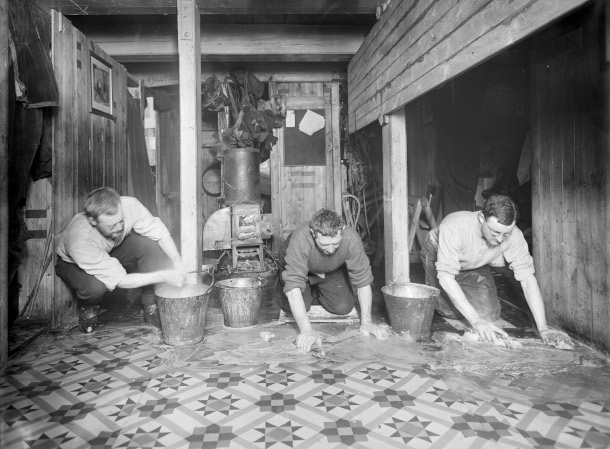
When ‘Endurance’ got trapped in sea ice, the crew aboard the ship kept their minds and bodies occupied by keeping up with their daily activities. (Photo: Manchester City Council, Flickr, CC BY NC ND 2.0)
CURWOOD: 2020 has been challenging, to put it mildly. The rising death toll from the virus pandemic is horrible, the mega storms and fires related to climate disruption are awful, the economic downturn is appalling and the social unrest linked to confronting systemic racism adds to a growing sense of uncertainty. In times like these it can be helpful to hear stories of people who survived extreme difficulties and how they did it. Rosamund Zander has written a book about just that, it’s titled Pathways to Possibilities: Transforming Our Relationship to Ourselves, Each Other, and the World. Roz says the key to getting through hardship is to work in ways that maximize the chances of having a good outcome. It’s not enough to just think positively, she says. One must take direct action and seize every opportunity to make things better. Roz Zander, welcome to Living on Earth!
ZANDER: Thank you for having me.
CURWOOD: Our pleasure. So let's face it, these are some difficult times, right? I mean, COVID-19 has pushed the world into a quarantine, that was unexpected, and a lot of people have fallen economically insecure. In your Pathways to Possibility there is a delightful set of stories to talk about dealing with, shall we call them difficult situations, how to overcome them and push through. And so what's the story you'd like to share with us from your book that resonates the most with these times?
ZANDER: Well, it may seem odd to you, but I think of a story about Ernest Shackleton. He was a British explorer, and living in the beginning of the 20th century. And he had an idea that he wanted to go explore the Arctic. And the first thing he did was to put out a job description. I'm going to read you his job description "men wanted for hazardous journey, small wages, bitter cold, long months of complete darkness, constant danger, safe return doubtful, honor and recognition only in case of success."
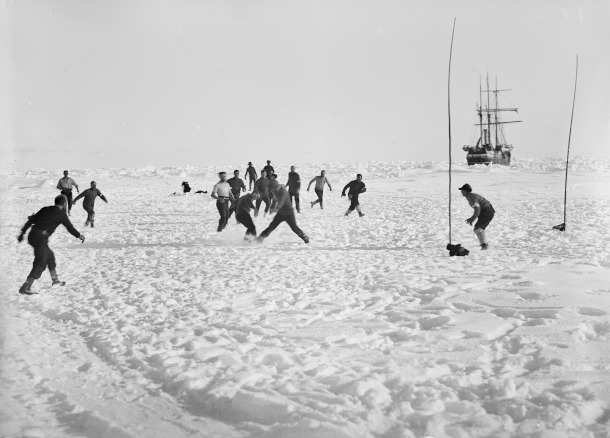
Men from the ship’s crew playing soccer while the ‘Endurance’ was trapped in sea ice. (Photo: Manchester City Council, Flickr, CC BY NC ND 2.0)
CURWOOD: [Laugh] So that sounds very difficult. Why? Why was it going to be so difficult?
ZANDER: Well, he got 28 men signing up with that kind of advertisement. They must have had a lot of adventures and thoughts, but it was much more difficult than they expected. And they set sail in Shackleton's boat, which was called the Endurance quite appropriately on August 6 1914, from the coast of England. Four months later, they were heading south on the coast of Antarctica and hit dense polar ice. By the end of January, the boat got totally trapped in the pack ice. And they had to wait there for 10 months patiently for a thaw in the ice because they couldn't move. After 10 months, the ice crushed the ship. Are we looking for troubles?
CURWOOD: Yeah.
ZANDER: So these 28 men camped on the ice for five more months, waiting for open water and enduring terrible hardships. Finally, they were able to sail their three lifeboats which they had rescued from the crushed ship to an uninhabited piece of rock called Elephant Island from which there was absolutely no hope of rescue.
CURWOOD: So no way to get off this island, huh?
ZANDER: No way to get off, except that they had their lifeboats. And Shackleton acted very quickly, because he knew that men were almost at the end of their ropes here. And he took five of them in a 22 foot lifeboat and set out on an impossible 800 mile journey through the world's worst seas at the worst time of year.
CURWOOD: What about the men who are being left behind? I mean, here they are, in this very difficult place their leader has left in this boat kinda doubtful the boat's going to get anywhere successfully. I mean, this is complete desolation.
ZANDER: It is, and they were left in the charge of Shackleton's first mate named Frank Wilde. And he understood how to lead men. And so as the men were waiting on the shore and watching the boats go off in the distance, some of them got tears in their eyes. And Frank Wilde got them to work immediately.
CURWOOD: So I guess we know this story because Shackleton must have had some success with that tiny boat on those big seas.
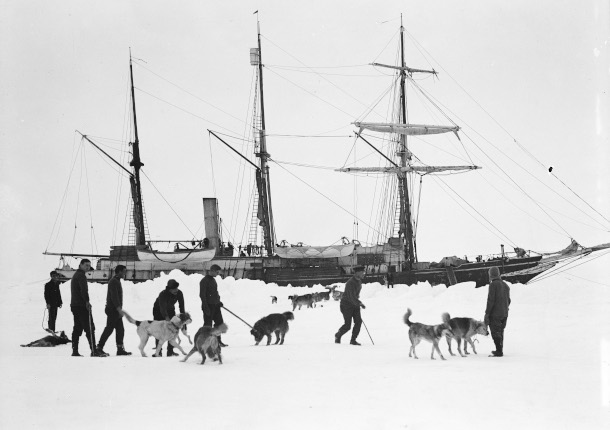
The Endurance, trapped in sea ice along the Weddell Sea. (Photo: Manchester City Council, Flickr, CC BY NC ND 2.0)
ZANDER: You're right. You know, the ending is going to be good, but it still has some lessons in it. So Shackleton realized they had to act quickly to get help. And so he took off in a 22 foot lifeboat, with five men, leaving the others behind. He set out on an impossible 800 mile journey through the world's worst seas, and that the very worst time of year. They aim for the nearest populated territory, which was South Georgia Island, and its whaling station. And they got there, but they landed on the wrong side of the island and had to climb 26 miles over the mountains and over the glaciers to get to the whaling station. It's hard to believe. They were hardly recognizable by the people working in the whaling station. They were so emaciated. They hardly looked like human beings. And then of course, Shackleton knows he's left 23 men behind and he gets into a sea worthy boat as soon as he can, and goes back the 800 miles to elephant Island.
CURWOOD: So what was the condition of those men who've been left behind?
ZANDER: Well they had suffered injury and infection, hypothermia, attacks by an elephant seal near starvation, completely unspeakable conditions. But not one member of the original 28 man crew was lost, not one, but the sink. How is that possible? Really? That's the question. And our best clue is that Shackleton remained consistently positive in his outlook and forbid the expression of negativity or despair. He declared, and when I love this, he declared that optimism is the true moral courage. Optimism is the true moral courage. Both Shackleton and Frank Wilde understood that they had to be completely disciplined with the men in keeping them from saying anything negative or going into despair, because that's the way they would survive. If there was a negative story hanging around and people were playing with it, "are we gonna make it?" they would very likely all have died in a short order time.
CURWOOD: So Roz why is it that in times of peril and stress, our minds tend to wander towards the negative thoughts instead of immediately jumping in to optimism?
ZANDER: Well, because we're wired that way. I meam it is a fear response, negativity is a fear response. You can't help but think of the possible dangers. Nature wants you to do that up to a point. But in such a time as COVID, or such an adventure as Shackleton's, it isn't useful. And you can overcome that wiring. But it takes discipline and effort to overcome it, you have to stay consistent of saying, tomorrow will be a better day. And that's the truth, as we know it.
Rosamund Stone Zander is the author of Pathways to Possibilities: Transforming Our Relationship with Ourselves, Each Other, and the World. (Photo: Courtesy of Rosamund Stone Zander)
CURWOOD: So when it comes to optimism, how important is it to be active about this as opposed to you know, just having an optimistic attitude and, and sitting there?
ZANDER: Well, it's very important because it's a disciplines what you're doing in optimism is overriding the wiring that we are given at birth, and to override wiring, it doesn't actually take you running around but it does take mental activity to do that. And then of course, telling other people to do the same. It's making a community keeping a conversation going, that lifts others as well and it does wonders for the immune system. actually. If you have a group of people who are all speaking in possibility, their physical state is different than those who are all in despair, it's completely different. And their immune systems are strengthened by optimism, not by positive thinking, not by lying to themselves. And optimism and positive thinking are quite different positive thinking occurs when you really know that something is bad, but you're hoping it will not be and you're going to pump yourself up to say it isn't but that's a lie. Positive Thinking is a lie. Optimism in the face of you could die or you could live the options are open, the future is open, you don't know the answer so that's not a lie that kind of optimism.
CURWOOD: Let's go back to Shackleton for a moment. How would the situation with Shackleton's men differed if they'd act based on positivity and not optimism? Do you think?
ZANDER: Well, the thing is that it's a lie and therefore it would show through. Somebody would be going into despair, and not know what to do about that. Whereas every man on this journey, knew what to do. They had to speak the story of survival that we are going to survive. And what happened was that they became very collaborative and when one man spilled his cup of milk four others rush to fill it up again, even though they were all starving.
CURWOOD: Well, I want to thank you for taking the time with me today. Rosemund Stone Zander is on Pathways to Possibilities: Transforming our Relationship with Ourselves Each Other and the World. Thanks so much.
ZANDER: Thank you so much. It was a great pleasure.
Related links:
- Learn more about Rosamund Stone Zander
- Learn more about Ernest Shackleton
[MUSIC: Scott Wilkie, “Eu Vim da Bahia” on Brasil, , by Gilberto Gil, Beach Music Studios]
CURWOOD: Living on Earth is produced by the World Media Foundation. Our crew includes Naomi Arenberg, Paloma Beltran, Jenni Doering, Jay Feinstein, Leah Jablo, Mark Seth Lender, Don Lyman, Isaac Merson, Aaron Mok, Aynsley O’Neill, Jake Rego, Casey Troost, and Jolanda Omari.
BASCOMB: Tom Tiger engineered our show. Alison Lirish Dean composed our themes. You can hear us anytime at L-O-E dot org, Apple Podcasts and Google Podcasts, and like us, please, on our Facebook page - Living on Earth. We tweet from @livingonearth. And you can find us on Instagram at livingonearthradio. I’m Bobby Bascomb.
CURWOOD: And I’m Steve Curwood. Thanks for listening!
ANNOUNCER: Funding for Living on Earth comes from you, our listeners, and from the University of Massachusetts, Boston, in association with its School for the Environment, developing the next generation of environmental leaders. And from the Grantham Foundation for the protection of the environment, supporting strategic communications and collaboration in solving the world’s most pressing environmental problems.
ANNOUNCER 2: PRX.
Living on Earth wants to hear from you!
Living on Earth
62 Calef Highway, Suite 212
Lee, NH 03861
Telephone: 617-287-4121
E-mail: comments@loe.org
Newsletter [Click here]
Donate to Living on Earth!
Living on Earth is an independent media program and relies entirely on contributions from listeners and institutions supporting public service. Please donate now to preserve an independent environmental voice.
NewsletterLiving on Earth offers a weekly delivery of the show's rundown to your mailbox. Sign up for our newsletter today!
 Sailors For The Sea: Be the change you want to sea.
Sailors For The Sea: Be the change you want to sea.
 The Grantham Foundation for the Protection of the Environment: Committed to protecting and improving the health of the global environment.
The Grantham Foundation for the Protection of the Environment: Committed to protecting and improving the health of the global environment.
 Contribute to Living on Earth and receive, as our gift to you, an archival print of one of Mark Seth Lender's extraordinary wildlife photographs. Follow the link to see Mark's current collection of photographs.
Contribute to Living on Earth and receive, as our gift to you, an archival print of one of Mark Seth Lender's extraordinary wildlife photographs. Follow the link to see Mark's current collection of photographs.
 Buy a signed copy of Mark Seth Lender's book Smeagull the Seagull & support Living on Earth
Buy a signed copy of Mark Seth Lender's book Smeagull the Seagull & support Living on Earth

